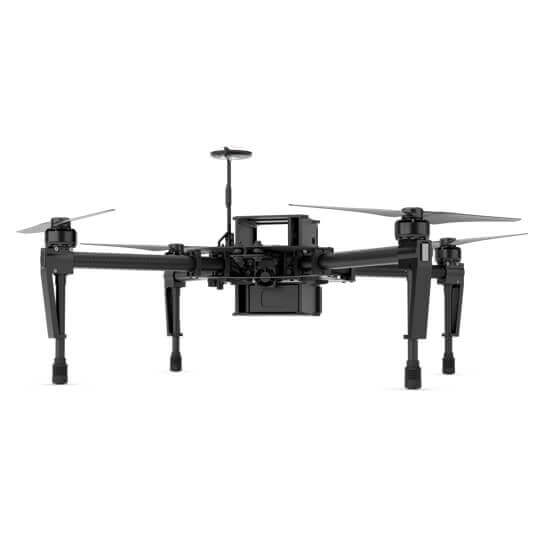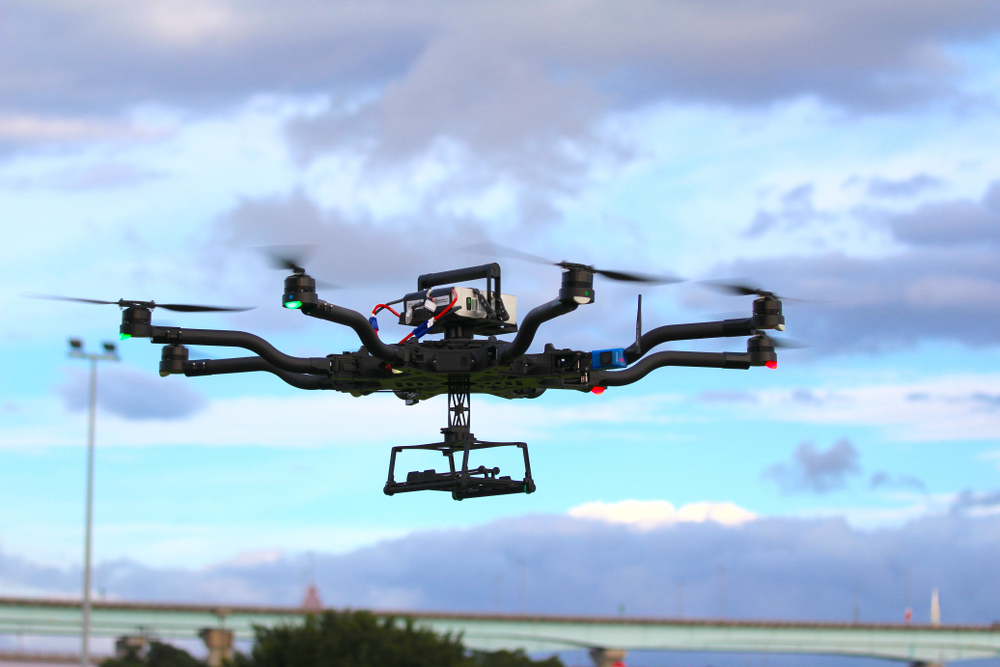Drones have revolutionized industries with their versatility, efficiency, and advanced technology. Among them, the largest ones stand out for their remarkable capabilities, from carrying heavy payloads to conducting extended missions in challenging conditions. These massive UAVs are used for everything from military operations and cargo transport to aerial photography and surveillance. In this article, we’ll explore some of the largest drones in the world, organized by their payload capacities, and dive into the impressive details that make each one unique.
DJI Matrice 100

The DJI Matrice 100 is a versatile quadcopter designed for developers and researchers. It has a maximum payload capacity ranging between 1.17 to 1.25 kilograms, depending on the configuration. With a flight time of up to 40 minutes without payload, it offers ample duration for various applications. It features a modular design, allowing users to customize it with different sensors and devices. Its dual battery compartments enhance power supply and redundancy. It is equipped with DJI’s Lightbridge technology, providing a control range of up to 5 kilometers. Its robust build ensures stability and reliability in diverse environmental conditions. It serves as a reliable platform for testing and development in the UAV industry.
DJI Matrice 600

The DJI Matrice 600 is a robust hexacopter designed for industrial applications and professional filmmaking. It has a maximum payload capacity of 6 kilograms, supporting a range of cameras and sensors. It integrates DJI’s A3 flight controller and Lightbridge 2 transmission system, ensuring precise control and long-range HD video transmission. Its modular design allows for easy setup and maintenance. The drone is powered by six intelligent batteries, providing redundancy and extended flight times of up to 35 minutes without payload. Its retractable landing gear offers an unobstructed view for the camera. With its high-performance design, it is a preferred choice for complex aerial tasks. Its adaptability extends to industrial applications such as inspections and surveying, making it a versatile platform.
DJI Spreading Wings S900

The DJI Spreading Wings S900 is a professional hexacopter designed for aerial photography and cinematography. It boasts a maximum payload capacity of 6.8 kilograms, accommodating high-quality cameras and equipment. It features a lightweight, durable frame made of carbon fiber, enhancing its portability and strength. Its foldable arms allow for easy transportation and quick setup. It is equipped with DJI’s advanced flight control systems, ensuring stable and reliable flight performance. With a flight time of approximately 18 minutes when fully loaded, it provides sufficient duration for capturing complex shots. Its retractable landing gear offers an unobstructed 360-degree view for the camera. This hexacopter is favored by professionals for its balance of payload capacity and maneuverability.
Freefly Systems Alta 8

The Freefly Systems Alta 8 is an advanced octocopter designed for heavy-lifting applications in professional filmmaking and photography. It has a maximum payload capacity of 9.1 kilograms, making it suitable for carrying high-end cameras and gimbals. It offers top and bottom mounting options, providing flexibility in camera positioning for unique shots. Its lightweight carbon fiber construction ensures a strong yet portable frame. It is equipped with the Synapse Flight Controller, which delivers precise and responsive control even in challenging conditions. With a maximum flight time of 16 minutes at full payload capacity, it supports efficient use in dynamic filming scenarios. The quick-release mechanisms allow for seamless setup and teardown, making it a favorite among industry professionals. Its reliable performance has made it a popular choice for aerial cinematography in demanding environments.
AeroVironment RQ-20 Puma AE

The AeroVironment RQ-20 Puma AE is a small, hand-launched UAV with a payload capacity of 12 kilograms. It is widely used by the military for surveillance and reconnaissance missions due to its portability and ease of use. It is powered by a lithium-ion battery, giving it a flight endurance of approximately 3 hours. Its modular payload bay allows for customization with various sensors, including electro-optical and infrared cameras. It is capable of operating in harsh environments, including maritime conditions, due to its rugged, waterproof design. With a range of up to 20 kilometers, it provides reliable intelligence over extended distances. It is highly valued for its ability to provide real-time situational awareness in challenging operational scenarios.
General Atomics MQ-1C Gray Eagle

The General Atomics MQ-1C Gray Eagle is a long-endurance UAV with a payload capacity of 261 kilograms. Designed primarily for the U.S. Army, it serves a variety of roles, including reconnaissance, surveillance, and strike missions. It has a wingspan of 17 meters and can stay aloft for up to 25 hours. It is powered by a 165-horsepower heavy-fuel engine, allowing it to reach a cruising speed of 280 km/h. It is equipped with multiple payload options, including synthetic aperture radar and electro-optical sensors, enhancing its mission versatility. Its advanced avionics and autonomous flight capabilities reduce the need for manual intervention during operations. Its ability to integrate with other battlefield systems makes it a critical asset in modern warfare.
TAI Aksungur

The TAI Aksungur, developed by Turkish Aerospace Industries, is a medium-altitude, long-endurance UAV with a payload capacity of 750 kilograms. Its impressive wingspan of 24 meters and twin-engine design provide stability and reliability during extended missions. It is capable of carrying a variety of payloads, including munitions, surveillance equipment, and electronic warfare systems. It can stay airborne for up to 40 hours, making it ideal for intelligence, surveillance, and reconnaissance (ISR) missions. It operates at altitudes of up to 12,000 meters, providing a wide operational range for diverse missions. Its six hardpoints allow for flexible payload configurations, including precision-guided munitions for combat scenarios. Its modular design enables quick adaptation to different mission requirements, enhancing its operational efficiency.
General Atomics MQ-9 Reaper

The General Atomics MQ-9 Reaper is one of the most recognized combat drones, with a payload capacity of 1,700 kilograms. Its 20-meter wingspan and 11-meter length give it an imposing presence in the UAV space. Powered by a 950-horsepower turboprop engine, it reaches a top speed of 482 km/h and can operate at altitudes up to 15,000 meters. It is widely used for precision-strike and surveillance missions, with an endurance of 27 hours. It is equipped with advanced targeting sensors and can carry a variety of weapons, including Hellfire missiles and laser-guided bombs. Its modular payload system allows for the integration of additional sensors for diverse mission profiles. It is a cornerstone of modern aerial operations, offering unparalleled versatility and effectiveness in combat and reconnaissance roles.
Boeing MQ-25 Stingray

The Boeing MQ-25 Stingray is a groundbreaking aerial refueling UAV developed for the U.S. Navy. With a payload capacity of approximately 6,800 kilograms, it is designed to extend the range of manned aircraft during missions. It features a sleek, stealthy design optimized for carrier-based operations, including folding wings for compact storage. Its advanced refueling system can deliver fuel to multiple aircraft mid-air, enhancing mission flexibility and endurance. It is powered by a Rolls-Royce AE 3007N turbofan engine, which provides reliable performance and operational efficiency. It is equipped with advanced autonomous navigation systems, enabling it to execute complex refueling tasks with minimal human intervention. It represents a significant leap in the integration of UAVs into naval aviation, supporting both combat and reconnaissance operations.
Stratolaunch Roc

The Stratolaunch Roc is the world’s largest aircraft by wingspan, designed to serve as a platform for launching rockets into space. While not a traditional drone, it operates as a massive UAV in specific applications, with a payload capacity exceeding 250,000 kilograms. Its dual-fuselage design and 117-meter wingspan make it a giant in aerospace innovation. Powered by six Pratt & Whitney PW4056 engines, it can transport and launch rockets, satellites, and other payloads at high altitudes. It is intended to make space launches more efficient and cost-effective by eliminating the need for traditional ground-based systems. It is equipped with cutting-edge avionics, enabling precise control during flight. Its versatility extends beyond space applications, with potential uses in scientific research and atmospheric studies. It redefines what is possible in unmanned aerial technology, paving the way for innovative aerospace missions.
This article originally appeared on Rarest.org.
More from Rarest.org
10 Oldest Castles in the World

Castles are some of the most enduring symbols of history, offering a glimpse into the past through their architecture and stories. These ancient fortresses have witnessed the rise and fall of empires, serving as both military strongholds and royal residences. Read More.
22 Unusual Insects Native to the World`s Most Remote Jungles

Deep within the world’s most remote jungles, some insects defy the imagination. These creatures are often stunning, bizarre, and unlike anything you might find in your backyard. Read More.
15 Lesser-Known Species on the Brink of Extinction

Many species around the world are facing the threat of extinction, but not all of them are well-known. While efforts to save popular animals like pandas and tigers often make headlines, lesser-known species are quietly disappearing at an alarming rate. Read More.
